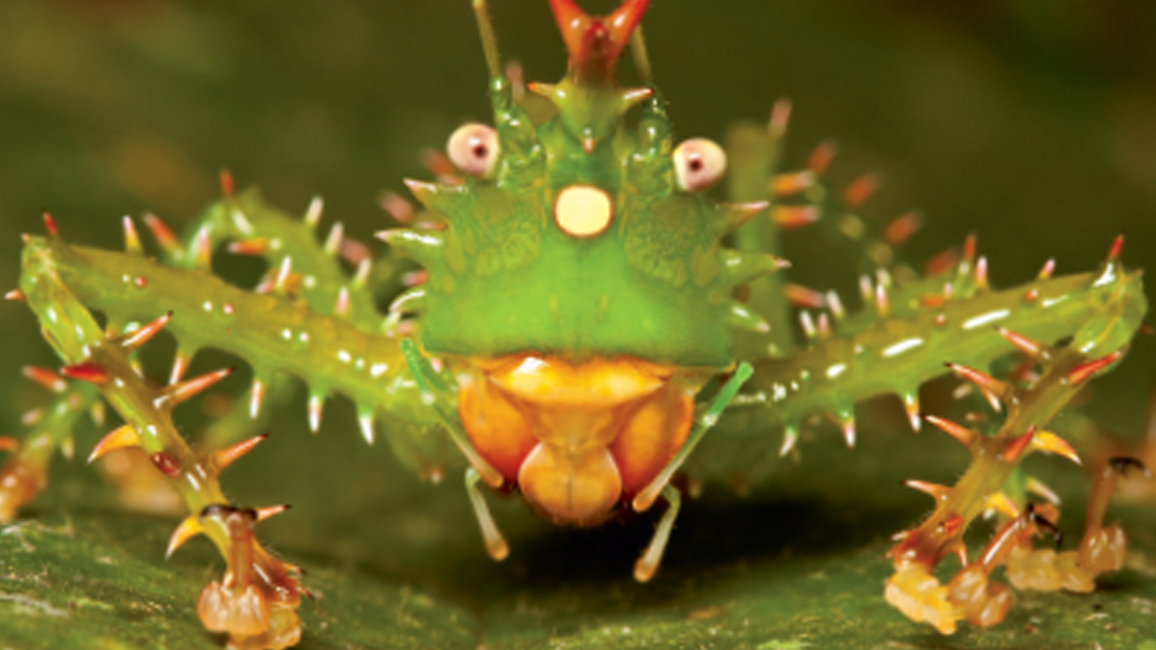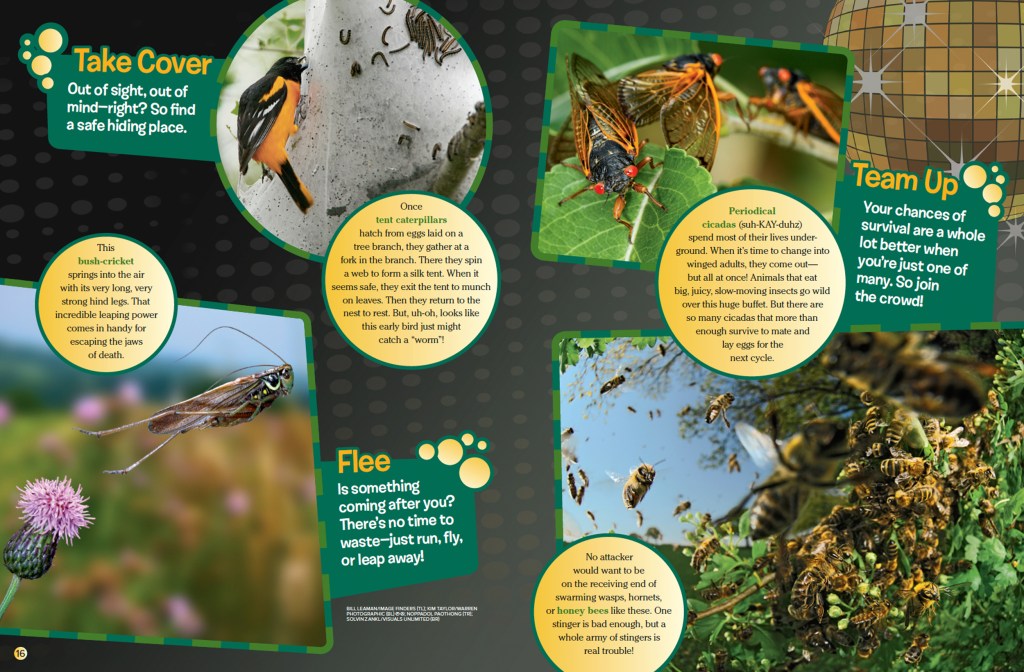
Stayin’ Alive
By Ellen LambethThere’s more than one way to avoid being eaten—especially if you’re an insect. Check out our tips in this handy self-help guide.
Insects have a major disadvantage: They’re perfectly bite-sized to many larger creatures with hearty appetites. This shield mantis is big enough to catch and eat lots of things, including other insects. But it’s not too big to become a meal itself for, say, a tarantula, bird, bat, or frog. Unless, that is, the mantis suddenly rears up and spreads out its spiky forelegs as this one is doing. That makes the mantis seem even bigger than it really is. Plus, its fierce-looking pose would make any hungry predator think twice before attacking.
Check out two other insects that use special tactics to fake out their foes.
Fake Out
Do something quick that startles your attacker and scares it away.
A brown, ordinary-looking moth caterpillar was threatened by something—or somebody. So it puffed out the front part of its body. That changed it from a timid caterpillar to a scary but fake snake—right down to its fake eyes and fake scales.
Normally, the io moth holds its front wings back, covering the hindwings. That makes the moth blend in well with those fallen leaves. But what if trouble brews anyway? Then it spreads the front wings to flash those big, fake eyespots that had been hidden underneath. BOO—surprise eyes!
Take Cover
Out of sight, out of mind—right? So find a safe hiding place.
Once tent caterpillars hatch from eggs laid on a tree branch, they gather at a fork in the branch. There they spin a web to form a silk tent. When it seems safe, they exit the tent to munch on leaves. Then they return to the nest to rest. But, uh-oh, looks like this early bird just might catch a “worm”!
Flee
Is something coming after you? There’s no time to waste—just run, fly, or leap away!
This bush-cricket springs into the air with its very long, very strong hind legs. That
incredible leaping power comes in handy for escaping the jaws of death.
Team Up
Your chances of survival are a whole lot better when you’re just one of many. So join
the crowd!
Periodical cicadas (suh-KAY-duhz) spend most of their lives underground. When it’s time to change into winged adults, they come out—but all at once! Animals that eat big, juicy, slow-moving insects go wild over this huge buffet. But there are so many cicadas that more than enough survive to mate and lay eggs for the next cycle.
No attacker would want to be on the receiving end of swarming wasps, hornets, or honey bees like these. One stinger is bad enough, but a whole army of stingers is real trouble!
Use a Disguise
Look like something else, and you might not be noticed or recognized as food.
What’s up with these damaged leaves? Ah, look again! The leaf on the left is actually a leaf katydid, with wings that look amazingly like the dying leaf next to it. Even if the katydid moves, it still looks like a leaf, fluttering in the breeze.
This hover fly is just a fly—which can’t sting. But it’s hard to tell that at first glance. It sure looks like a bee or wasp—which, of course, can sting. So, a hungry attacker might think it’s smarter to leave the hover fly “bee.”
Fight Back
Sometimes, there’s no easy way out of danger. That’s when to rely on your secret weapon.
This spiny devil katydid looks scary enough. But what if something tries to take a bite
anyway? It will get a mouthful of sharp pokers, especially when the insect punches out with those prickly forelegs.
The insect with the ultimate weapon just might be this bombardier beetle. When attacked (even if it’s just by someone’s finger), it blasts out a hot chemical spray from its rear end. Bombs away!
These shield bugs have red and black stripes for good reason. The colors are a warning sign that says, “Stay away!” Any hungry bird that ignores the sign will get a yucky dose of stinky stuff.
Final Tip
If a wasp stinger like this one shows up in your future, you may have reached an unhappy
“ending.”
“Stayin’ Alive” originally appeared in the June/July 2016 issue of Ranger Rick magazine.
(Click on each image above for a closer view of the story.)



















